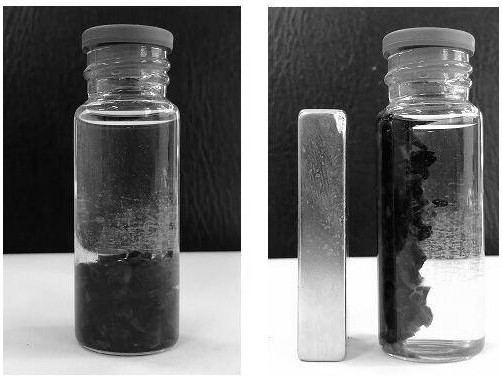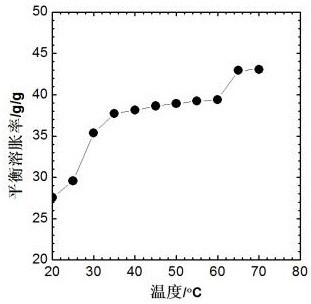Preparation of a magnetic chitosan semi-interpenetrating heat-expandable hydrogel and its application in cr(vi) adsorption
A technology of hydrogel and chitosan, which is applied in the field of wastewater treatment and material synthesis research, can solve the problems of high cost, low adsorption capacity, and failure to meet the needs of practical applications, and achieve the effect of low cost and improved adsorption efficiency
- Summary
- Abstract
- Description
- Claims
- Application Information
AI Technical Summary
Problems solved by technology
Method used
Image
Examples
Embodiment 1
[0027] A preparation method of magnetic chitosan semi-interpenetrating heat-expandable hydrogel, comprising the following steps:
[0028] (1) Weigh 3.2g of acetic acid and 1.4g of chitosan at room temperature and dissolve in 60.0g of distilled water. Under stirring, add 18.0g of acrylamide monomer and stir to dissolve completely, and slowly add 16.0g under vigorous stirring. After the temperature-sensitive macromonomer was completely dissolved, nitrogen was introduced for 30 minutes, 0.2 g of N,N-methylenebisacrylamide and 0.1 g of 2-ketoglutaric acid were added in sequence, and nitrogen was continued for 30 minutes. In situ radical polymerization was initiated by irradiation with UV light at 365 nm for 6 h to obtain a transparent elastic hydrogel.
[0029] (2) The transparent elastic hydrogel obtained above is cut into pieces, and freeze-dried at low temperature to obtain a chitosan semi-interpenetrating heat-expandable hydrogel.
[0030] (3) The obtained chitosan semi-inter...
Embodiment 2
[0032] A preparation method of magnetic chitosan semi-interpenetrating heat-expandable hydrogel, comprising the following steps:
[0033] (1) Weigh 3.2g of acetic acid and 2.8g of chitosan at room temperature and dissolve it in 60g of distilled water. Under stirring, add 18.0g of acrylamide monomer and stir to dissolve completely, and slowly add 16.0g of warm water under vigorous stirring. After the sensitive macromonomer was completely dissolved, nitrogen was introduced for 30 min, 0.2 g of N,N-methylenebisacrylamide and 0.1 g of 2-ketoglutaric acid were added in sequence, and nitrogen was continued for 30 min. In situ radical polymerization was initiated by irradiation with UV light at 365 nm for 6 h to obtain a transparent elastic hydrogel.
[0034] (2) The transparent elastic hydrogel obtained above is cut into pieces, and freeze-dried at low temperature to obtain a chitosan semi-interpenetrating heat-expandable hydrogel.
[0035] (3) The obtained chitosan semi-interpenet...
Embodiment 3
[0037] A preparation method of magnetic chitosan semi-interpenetrating heat-expandable hydrogel, comprising the following steps:
[0038](1) Weigh 3.2g of acetic acid and 1.4g of chitosan at room temperature and dissolve it in 60g of distilled water. Under stirring, add 16.0g of acrylamide monomer and stir to dissolve completely, and slowly add 34g of temperature sensitive under vigorous stirring. After the macromonomer was completely dissolved, nitrogen was introduced for 30 min, 0.2 g of N,N-methylenebisacrylamide and 0.1 g of 2-ketoglutaric acid were added in sequence, and nitrogen was continued for 30 min. In situ radical polymerization was induced by irradiation with UV light at 365 nm for 6 h, and a transparent elastic hydrogel was obtained.
[0039] (2) The transparent elastic hydrogel obtained above is cut into pieces, and freeze-dried at low temperature to obtain a chitosan semi-interpenetrating heat-expandable hydrogel.
[0040] (3) The obtained chitosan semi-interp...
PUM
| Property | Measurement | Unit |
|---|---|---|
| wavelength | aaaaa | aaaaa |
Abstract
Description
Claims
Application Information
 Login to View More
Login to View More - R&D
- Intellectual Property
- Life Sciences
- Materials
- Tech Scout
- Unparalleled Data Quality
- Higher Quality Content
- 60% Fewer Hallucinations
Browse by: Latest US Patents, China's latest patents, Technical Efficacy Thesaurus, Application Domain, Technology Topic, Popular Technical Reports.
© 2025 PatSnap. All rights reserved.Legal|Privacy policy|Modern Slavery Act Transparency Statement|Sitemap|About US| Contact US: help@patsnap.com



